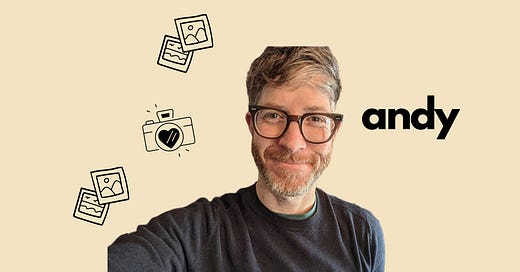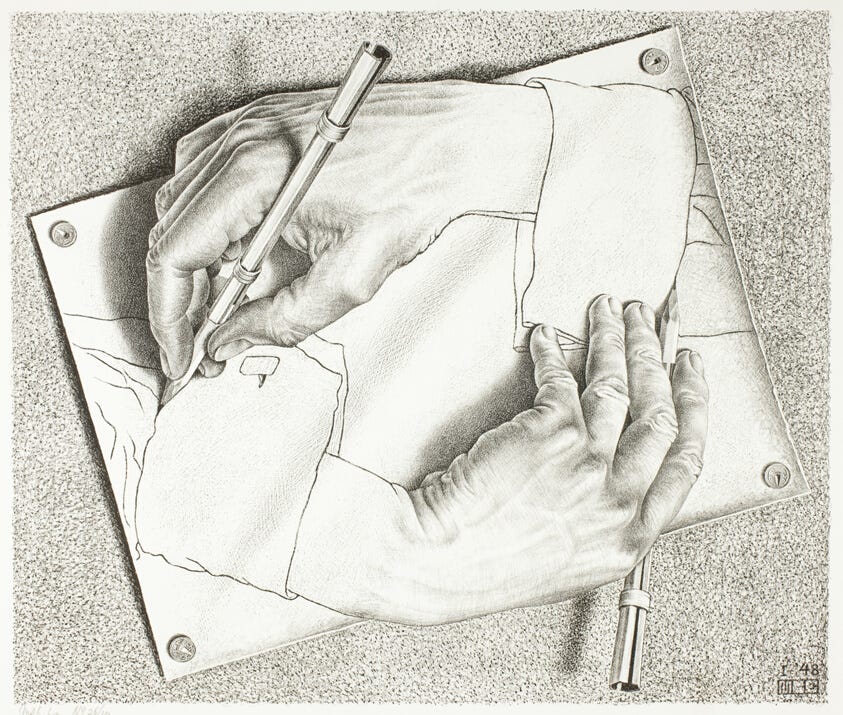Welcome to Mia’s Queue, a newsletter spotlighting the secret agents of taste among us. In each edition, I chat with an undercover tastemaker infusing creativity and wonder into their (and our!) everyday life. Learn what lights them up, where they find inspiration, and what they think we should all be enjoying right now. Meet Agent 017:
, the curator and director of FlakPhoto Projects.My friendship with Andy started out as a “cold call” via LinkedIn. Andy politely reached out to me, said he liked my background, and asked if we could chat. I’m not sure what compelled me to say yes, but I liked his profile too: FlakPhoto is a photography lover’s and curator’s dream. The man has an EYE, and I wanted to know how I could cultivate my own.
This conversation is excerpted and edited from our much longer chat, when Andy was my season-opening guest on Flipboard’s “The Art of Curation” podcast. He was also Flipboard’s Photography Curator in Residence during the summer of 2023. I love following his Flipboard Magazine, FlakPhoto Reads, to see what’s inspiring him outside of our Zoom calls.
You’ve taught me about the difference between looking and seeing. Can you explain that distinction?
It’s a subtle one. We can look at things all day long, but not really see what they mean. You might look at a picture of a landscape, and it will mean something to you, but when you're provided context…it adds various levels of meaning. That really is why I find the curatorial practice fascinating and important — and even critical in this day and age, with so many images circulating without context.
How can any of us train our eyes to become more discerning like yours?
Two things: I would imagine everyone has a camera phone. One way to hone your vision would be to make pictures every day and start to see what looks good in a picture. I do it every day. That includes photographing ordinary things like your house. I can't tell you how many times I've photographed the way the light is falling in my own little house because it's just where I happen to be. I truly believe that every place is photographic if you can see it that way. Practice making your own pictures a little bit every day, using the camera that you have — the best one you have is the one in your pocket.
The other thing is to look at pictures every day to see a diversity of images. In the history of human culture, we've never had a time that has been better for learning about photography. There are images everywhere. Hopefully, somebody like me can help you see some of the good stuff, but I'm not the only one.
The image that comes to mind is MC Escher’s drawing hands, where one hand is essentially drawing the other.
I have started to see influences from the image makers I admire turn up in my own pictures. And that in turn influences the kinds of work that I seek out and show. You have to keep your mind open. And you have to be willing to see with fresh eyes every day.
This reminds me of an On Being podcast I listened to with Rick Rubin. He talks about working hard every day to notice something new. I've been trying to do that myself.
I agree. The new thing I'm on right now is examining the parallels between mindfulness, attention and noticing, and photography, walking and seeing. There are all these connections between these various things. It's not easy to pay attention. The culture is so noisy, and the media essentially is bombarding you with a firehose of inputs. You do have to learn how to pay close attention and to really notice and appreciate things. I too am working on that. In a way, what I'm doing with FlakPhoto is strengthening that muscle.
I'm so easily distracted — I have a lot of work to do still — but I have believed for a number of years now that photography is good for you. And I think that's part of how practicing photography, looking at photography, thinking about photography — it’s all good for your mind and wellbeing, I really believe that.
You're a phenomenal community builder. What are some of your first principles when it comes to that practice?
Thank you for the compliment. That's nice to hear. My whole community-building experience is one of learning by doing. I didn't study anything formally; I didn't even intentionally set out to create a community. I just started as a person who wanted to be part of the community.
I live in Madison, Wisconsin. When I first started on this 20 years ago, I didn't know anybody in my town who was doing photography. When I realized that it was happening on the internet, I ate it up, I couldn't get enough of it.
When we were kids, my mom taught us: “Don't do unto someone what you wouldn't have them do unto you.” The Golden Rule. Be kind, be empathetic, be nice, be polite, be courteous, be helpful, be useful — these are all values that I think about every day. I do my best to live by them every single day.
The internet's certainly not known for encouraging that kind of a value system. It’s been painful at times, having to learn how that works, because I’ve had to shoulder the psychic burden of bad vibes. But it also has been a really positive experience over the years, teaching me how to communicate with people. We all have a bad day sometimes. When I go online, I try to bring my best self, and I always encourage my fellow community members to do the same.
OK, now let’s get to your recommendations. Can you share your favorite photography media?
📕 “The Nature of Photographs: A Primer” by Stephen Shore
He's a professor of photography at Bard and has been teaching photography for many years. He took his classroom lessons and turned them into a book that talks about the formal qualities of pictures and how pictures work and operate within the world. I love to think about things on that level.
📗 “The Mindful Photographer” by Sophie Howarth
I would wake up, open this book, and read a chapter every morning. Sophie pairs pictures with mindfulness lessons that are about awareness and attention and the way we move through the world.
This podcast is great.
📺 Art21 YouTube channel
I love going to the archives and watching Art21 videos on YouTube. They profile artists from all walks of life and across disciplines. It’s a great way to learn about people who make the art.
So much of the time we're focused on the art itself, but I always love to learn about what inspires the people who make it.
• The best place to follow
is right here on .• He’s also on Instagram, Flipboard and many other places.
For the full version of this interview, check this out:
Mia’s Queue is a free newsletter featuring an ordinary person with extraordinary taste. Subscribe to get posts like this in your inbox every other Thursday.
More Mia’s Queue: Sebene • Gil • Alison • Alexis • Storey • Meg • Sadia • Kel • Tracy • Theresa • Vasha • Eva • Sarah • James • Adi • Letitia






Thank you so much, Mia! I was on vacation when this originally ran and I'm only now catching up on the post. It's an honor to be in your pages. I love what you do. Thanks again for having me on the show!